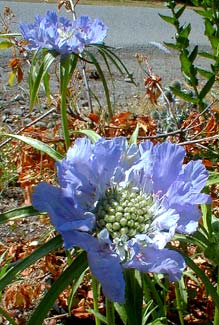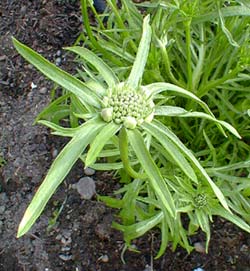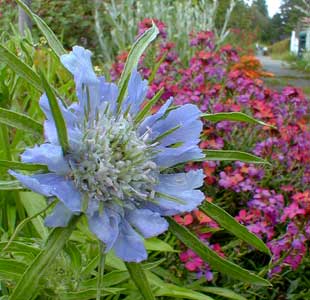
'Perfecta Blue'
Scabious; or,
Pincushion Flower
"Endless lanes sunken in the day
Bays, & traverses,
fringed with wasted verdage
Seed-pods of blue scabious,
& some lingering blooms,
& the sky, seen as from a well,
Brilliant with frosty stars."
-Frederick Manning
(1882-1935)
(1882-1935)
Scabiosa caucasica, a native of the central Caucasus mountains, has finely textured basal leaves which form a clump of about eighteen inches high & wide, with long stems supporting the flowers two to three feet high.
Large (three & a half-inch) pastel blue or lavender pincushion flowers with blue-petalled fringe are faintly poppy-like in their impression. The flowers arrive as an immediate prelude to summer. The first photo is from late June 2003. The third photo is from May 2004, with the addition of a 'Wenlock Beauty' Wallflower showing in the background.
 The center of each bloom on closer inspection is the classic pincushion of less ornate pincushion flowers, but with an additional circle of petals giving it the fringed look.
The center of each bloom on closer inspection is the classic pincushion of less ornate pincushion flowers, but with an additional circle of petals giving it the fringed look.A spiked green collar under the blue ruffle further extends the impression of largeness & strangeness of the flowers.
These spike-sepals are already quite striking before the green buds turn to fringed pincussions, so that even the buds are beautiful oddities. The second June photo shows just a bud.
With a combination of deadheading & cutting flowers for bouquets, it can be encouraged to keep blooming until first frosts, though if permitted to go to seed it is apt to stop blooming until the next summer.
It wants to be planted in full sun. Soil should be a little moist during the blooming period, but very well draining; during winter dormancy it is somewhat susceptible to rootrot, so sharp drainage is all the more important then.
 It best likes slightly alkaline soil, which is hard to provide on Puget Sound where soils are naturally acidic.
It best likes slightly alkaline soil, which is hard to provide on Puget Sound where soils are naturally acidic.A little lime, or a piece of blackboard chalk inserted into the roots at the start of each spring, may be of benifit without having to amend the surrounding soils.
However, we haven't bothered to do this & the clump does fine in a roadside garden. The soil along the road being poorer is actually better for 'Perfecta' than would be any humusy garden spot.
It can be grown down to zone 3, but needs mulching for winter protection. It needs no such special consideration here on Puget Sound.
As the clump enlarges, it tires itself out, until by the fourth year it no longer performs well. Digging it up in spring & dividing it into smaller clumps will put it back in action. While it is out of the ground it is important to break loose the woodier thick parts of the root to compost, which will greatly assist the divided clump restore itself.
The 'Perfecta' cultivars "Blue" (or "Lilac") & "Alba" (or "White") are standards of the cut flowers industry in Europe & America, because it is so long-blooming & because the stalks are both long & sturdy. In one's own cutting garden, these are butterfly attractants par excellence.
Scabiosa atropurpurea 'Ace of Spades'